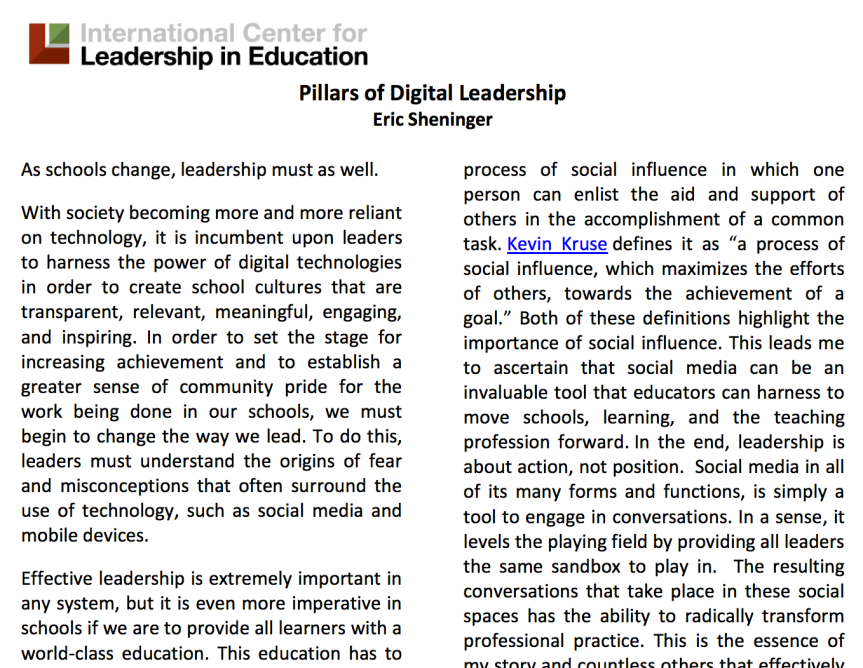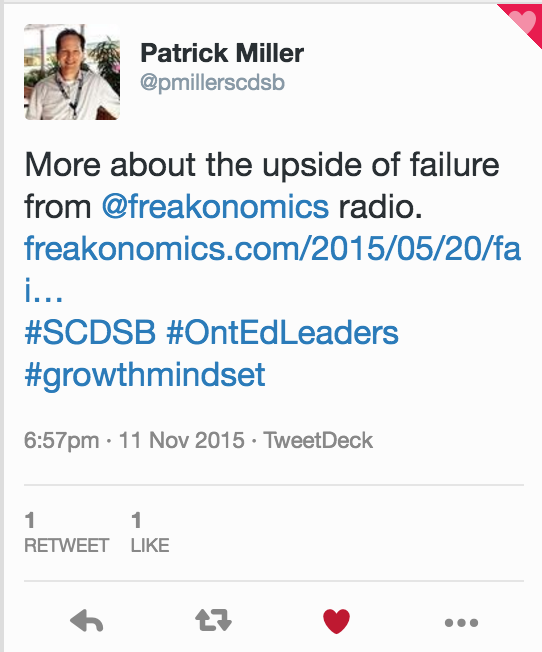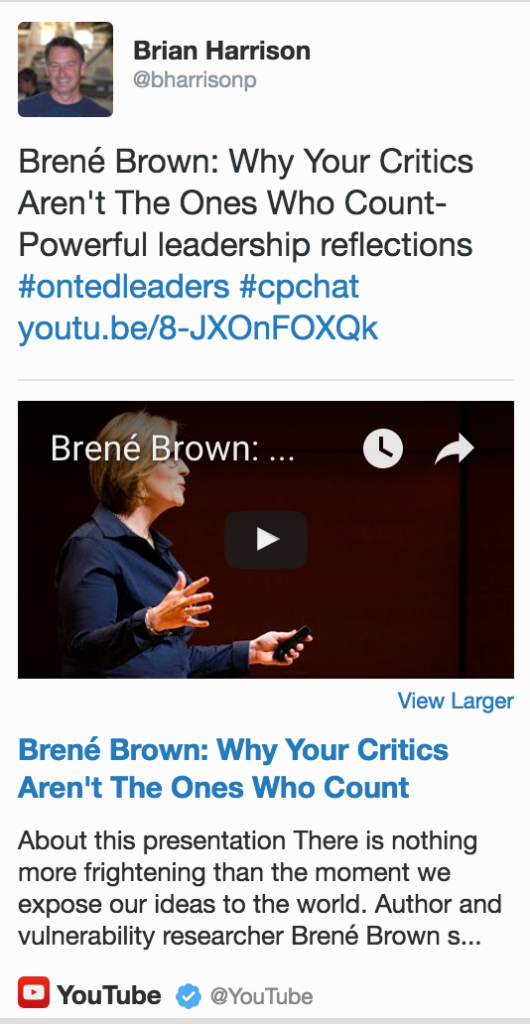Why is it so essential that School and System Leaders are Connected Digital Leaders? There are many reasons. Below is a summary of a few of them. At the bottom of this page you will find resources to further support your understanding of Connected Digital Leadership in Education.
Isolation is the Enemy of all Improvement – Everyone we meet knows something we don’t. Participating in open networks gives ideas opportunities to spread. “Crowd Accelerated Innovation” is a concept explained by Chris Anderson in this TED Talk. If we want to build innovative schools and systems, our leaders must be connected to the best ideas.
Educators who know how to self-direct their learning online with their peers from around the world, have access to all the best thinking, the best strategies, and the best conversations about how to help each and every child learn.
Digital citizenship is not something to be taught in isolation as a “subject”.
Digital citizenship is a way of being, to be integrated into all that we do (@TanyaAvrith). The Alberta Teachers’ Association Report on the State of the Principalship in Canada showed that concerns around social media and cyberbullying were prevalent among Principals across Canada.
Every one of our students will be googled – how are we helping them create positive digital footprints for the future? It is critical that our leaders have a full understanding of digital spaces to be able to model digital leadership for our students. OSAPAC curates resources for educators here.
If you don’t understand the digital environment, you are becoming illiterate. Doug Belshaw explains the essential elements of digital literacies in his TEDxTalk. We would never tolerate an illiterate leader in education in the traditional sense of “literacy”, and if we consider literacy to be the ability to communicate in particular contexts, today’s digital world needs digitally literate education leaders.
Our learning community exists in BOTH physical and digital spaces.
This quote from Dr. John Malloy, formerly the Director of Education for HWDSB (currently Ontario’s Chief Student Achievement Officer), reminds us of the critical importance of choosing leaders with the capacity to make great decisions about student learning in both physical and digital spaces:
“Using technology is no longer an option for us. We must support our students to succeed in our physical and digital world. Students who do not have this opportunity to learn in the digital world will be disadvantaged, something that we cannot accept.”
Our learners, our audience and our community are in online spaces. We need to be where they are.
“Isolation is inconsistent with professional practice.”
Catherine Montreuil, Director of Education, BGCDSB, August 2014
(Currently Assistant Deputy Minister of the Ontario Ministry of Education)
We can’t just “close the door and teach” any more. The smartest person in the room is the room, unless someone in the room is a connected leader, and then it’s the world. We need leaders who bring the world to their schools and districts.
“…. as capacity gets higher (which is certainly the case in Ontario), peers become the main source of innovation if you are to go from greatness to excellence.”
Michael Fullan
Great to Excellent: Launching the Next Stage of Ontario’s Education Agenda
How does a shift occur from a culture where learning is provided to a culture where learning is sought?
Today, it’s no longer about content. It’s about networks. Our Principals and Superintendents are Lead Learners. Leaders need to model networked learning for teachers and students. Connected leaders demonstrate that networking (Education 3.0) is a priority. We need to show our students what our learning looks like. We need to demonstrate to teachers how we learn. We need to share our thinking, leave it open to conversations, and let it be questioned.
As leaders, our professional portfolios should be ePortfolios, online where we can model this practice for others, and demonstrating how our work aligns with the Leadership Framework. George Couros has written about this extensively.
We have a moral imperative to share.
If there is no sharing, there is no learning.Live-tweeting at learning events is a great start, but why shouldn’t everyone could benefit from your learning? When you share the learning on your blog, it becomes searchable to everyone. Educators from around the world now have free access to that learning.If nobody shares, nobody learns!
Put Open and Access at the centre of your learning.
As a connected leader, you bring a world of learning to your practice. If leaders aren’t learning online, how can they make good decisions around what technology to purchase with public funds, and what learning is required so the teachers can make effective use of technology for deep learning in their classrooms?
Leaders must be participating in “deep learning” so they can understand what that learning looks like, and they can make valid, essential decisions about how to spend funds and time that are critical to moving learning forward.
If leaders do not understand how technology can enable their learning to become a seamless part of their daily lives, they will not understand the importance of their students’ access to the tools for learning.If you are not a connected leader, there is no better time to start! OSSEMOOC shows you how in 10 minutes a day.
The End Game Keeps Changing: What’s an Education Worth Having in 2015?
Getting better at old strategies won’t work. An education worth having in 2015 is not the same as an education worth having in 2000. If the world is changing faster than the school system, the school system is doing an excellent job of moving toward irrelevance.Here is some further thinking on this idea: https://fryed.wordpress.com/2015/06/29/whats-an-education-thats-worth-having
Connected Leaders Drive Student Achievement
Student achievement is impacted by connected leadership. The connections are explained here.
Resources:
How do we learn to become Connected (Digital) Leaders?
OSSEMOOC by OSAPAC:
Connected Leadership in 2015-2016
30 Days to Getting Connected in 10 Minutes a Day: Start on Day 1 Here
What is OSSEMOOC?
Resources – What’s out there to support leaders? (A Mindomo Resource by Joe Russo, TELT TCDSB
Margaret Wheatley: Are you willing to be disturbed?
ISTE Standards for Administrators
How do we, as leaders, enable those in our ‘buildings’ to become connected educators?
Digital Leadership (Eric Sheniger – for purchase)
What is a Connected Educator? (Tom Whitby)
Is Isolation in Education a Choice? (Tom Whitby)
Digital Leadership by @SylviaDuckworth and @JCasaTodd
From Digital Citizenship to Digital Leadership – guest post by Jennifer Casa-Todd
Share this: Please share with colleagues, especially those not yet self-directing their learning through social media








 3. Brian Harrison shared
3. Brian Harrison shared 